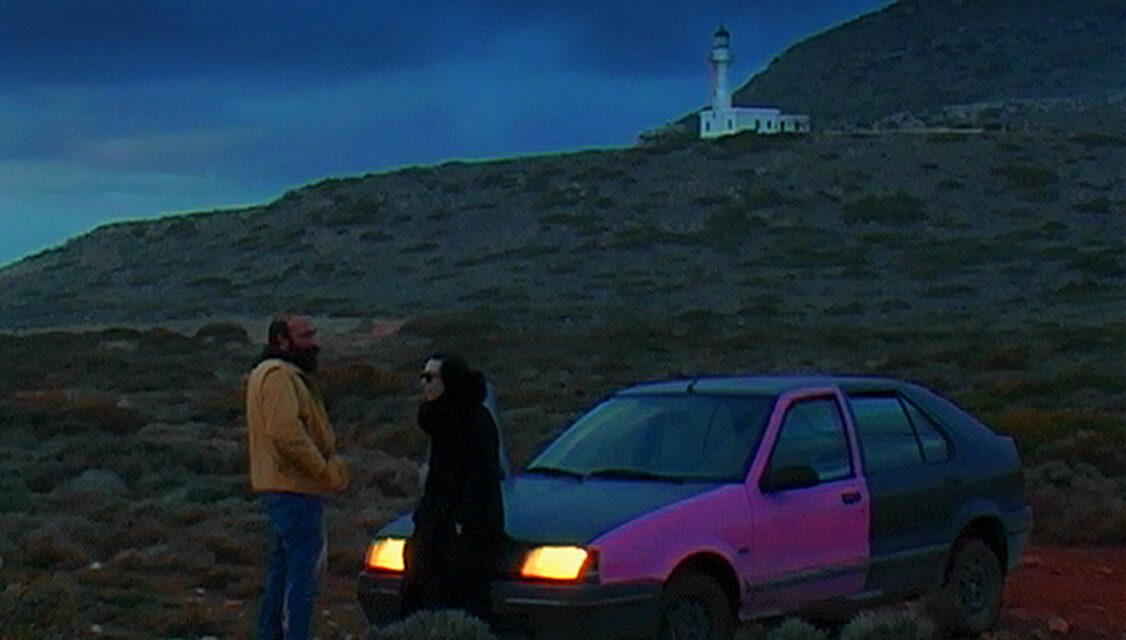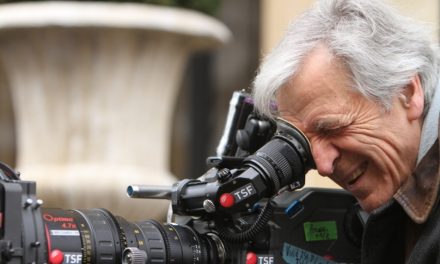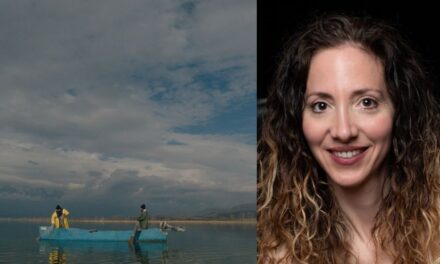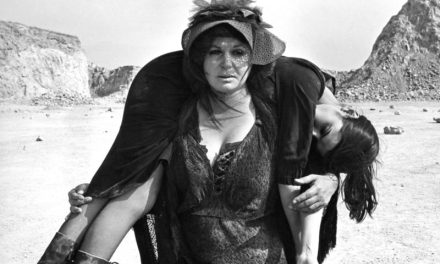“Having met by chance on the way to an island, a woman and a man decide to wander around together in search of a good place to bury a metallic box.” Elena is a dancer, a wife and mother, running away from a stifling reality; Antonis is a lonely man, looking for a place to bury his aunt’s ashes. The road brings the two characters together on a journey with no set destination.
Magnetic Fields is a veritable road movie, filmed with a MiniDV camcorder. It is the debut feature film of Yorgos Goussis, who is known primarily for his work in comics; he also wrote the screenplay, along with the two starring actors, Elena Topalidou and Antonis Tsiotsiopoulos (who share first names with their respective characters). A production of MiniFILMS, Naked Eye Productions and Heretic, the film was co-produced by the Greek Film Centre (GFC).
The film debuted at the 62nd Thessaloniki International Film Festival (4-14 November, 2021), where the director enjoyed a huge success: he won the newly-founded Golden Alexander –Film Forward award for “narrating the adventure of an encounter through adventure filmmaking in free flowing and humanistic way”; the FIPRESCI Award for the Greek film section of the Festival; the award of the Greek Association of Film Critics (ΠΕΚΚ), for making a road movie where “the ride is an analogy for the course of life, with the hope for a miracle lying at the end”; the first prize of the Hellenic Broadcasting Corporation (ERT) awards; and the award given by the Greek Film Centre to first-time directors, for his “tender road movie where the weaknesses of the heroes bring them face to face with their need for a new direction in life”. The film’s location manager, Marinos Sklavounakis, was also presented with the Location Award by GFC’s Hellenic Film Commission.
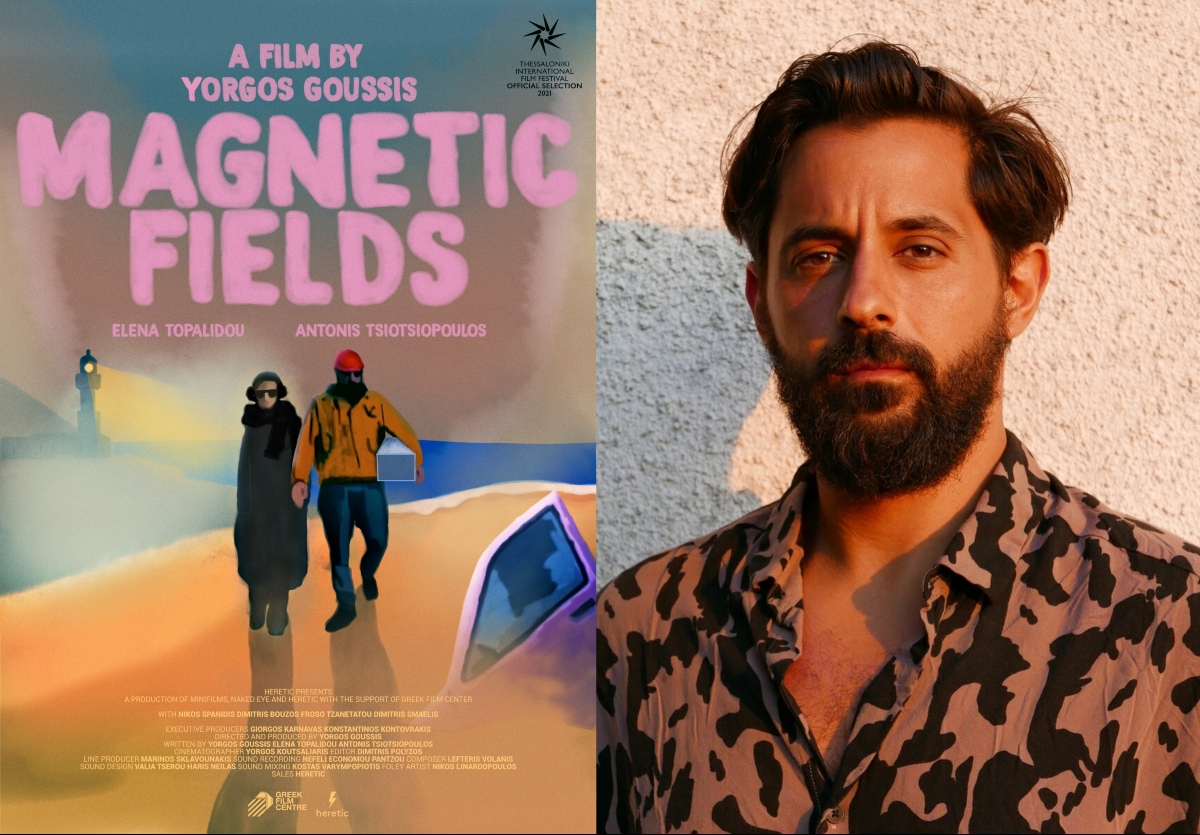 Yorgos Goussis was born in 1986 in Athens; he is an acclaimed comic book artist, with several best seller graphic novels and awards to his name. In 2012, he released the collection of short stories Tales from innocent times (ΚΨΜ publications), and in 2017 the graphic novel adaptation of Vincenzo Cornaro’s Erotokritos (together with Dimosthenis Papamarkos and Yannis Rangos, Polaris Publications), which won five Greek Comics Awards. Between 2017 and 2019, he acted as editor-in-chief for the Greek comics magazine Blue Comet.
Yorgos Goussis was born in 1986 in Athens; he is an acclaimed comic book artist, with several best seller graphic novels and awards to his name. In 2012, he released the collection of short stories Tales from innocent times (ΚΨΜ publications), and in 2017 the graphic novel adaptation of Vincenzo Cornaro’s Erotokritos (together with Dimosthenis Papamarkos and Yannis Rangos, Polaris Publications), which won five Greek Comics Awards. Between 2017 and 2019, he acted as editor-in-chief for the Greek comics magazine Blue Comet.
In 2018 he was the production designer of the Greek short film Iskioma (Faliro House Productions). In 2019 he debuted as a director with the short documentary The arm wrestler, which was awarded second place in the Best Short Film category at the 25th Athens International Film Festival, and was named Best Short Documentary for 2020 by the Hellenic Film Academy.
In 2019, Goussis was commissioned by the Thessaloniki International Film Festival to produce, together with Panayiotis Pantazis and Georgia Zachari, the 180-page-long comic book Festival, an anniversary edition to mark the 60 years since the launch of the festival. In 2020 his graphic novel Bandits (where he once again works with Yannis Rangos) was issued by Polaris Publications, while in 2021 the same house also published his graphic novel Days of Worship, a collaboration with Panayiotis Pantazis.
Greek News Agenda interviewed* Goussis about his original take on the road movie genre, his experience as a first-time director, his transition from comics to filmmaking and his future plans both as a director and a comic book artist.
You won several awards at the 62nd TIFF; among the reasons cited for the film’s selection were its focus on human contact and its hopefulness – two things that seem hard to come by at this time. Has the current state of the pandemic affected the core of your film?
Judging Magnetic Fields by the end result rather than my own intentions (which only function as a motive to get me to work), I come to the conclusion that it is a film exploring the power of togetherness. Taking that into consideration, it’s hard not to think that the period we’re going through hasn’t affected the film. Especially since we’re talking about a film which relied heavily on improvisation, drawing on personal experience and on the emotion of the eight people involved in the filming process. We were all traveling, eating and living together round the clock, and as a result we felt free again and came face to face with our feelings. The big question on the set was whether what we were feeling there, during those days, would find its way into the film. The viewers and the juryies at TIFF answered this question positively, and we were honoured and moved us with their remarks and awards. We thank them from the bottom of our hearts. We gained a lot from this filmmaking experience ourselves, and we are very happy that we were able to give it back to the audience.
Just 2 years ago, you created (together with Panayiotis Pantazis and Georgia Zachari) a comic book for the 60th TIFF. How did you feel walking up the stage at this year’s festival as an award-winning director?
Weird. Of course it was a great honour and a highlight in my career as a comic book creator to be commissioned to create the special edition for the Festival’s 60th anniversary. Through the process of making the book, which we really enjoyed, I found out a lot about the TIFF experience, and to visualise stories and characters in this setting. So, it was very strange when two years later I participated in the festival, this time as a filmmaker, that is, a potential character from the comic I had created. I found myself in a mise en abyme, an unprecedented narrative maelstrom, just like the comic, which mixed reality with fiction. On the plus side, one of the two main characters in the comic book was a male director who, in the second chapter, went to the festival with his first feature film; so since I went to the festival this year as a male director with my first feature film, I knew exactly the type of person I should not be. Those who have read the comic know what I am talking about.
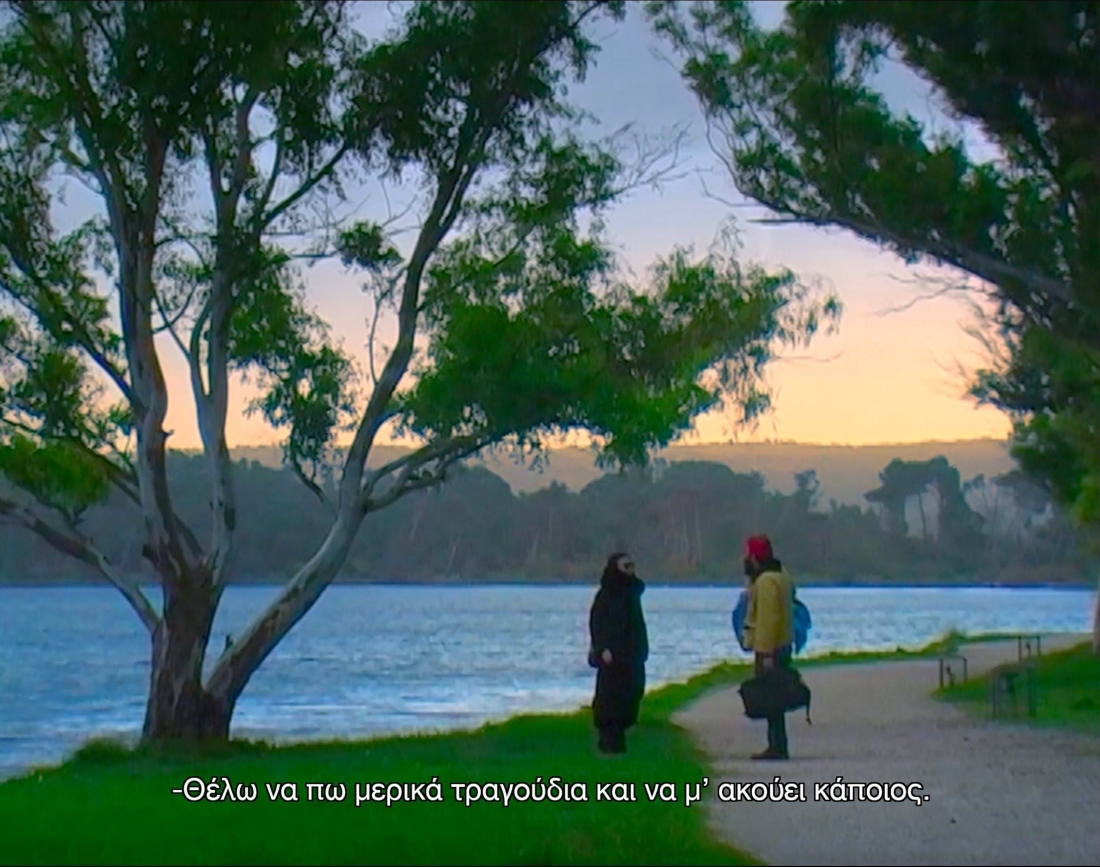 Still from Magnetic Fields
Still from Magnetic Fields
The two actors starring in the film are credited as co-writers of the script; to what extent is this is also their film? How much of you and how much of the actors themselves can be found in the two main characters? Did you have these particular people in mind when you started planning the film?
Antonis (Tsiotsiopoulos) and I have been friends for some time now, and I always wanted to work with him at some point, because we have common tastes and he is a caring and giving person in his collaborations. He is also a screenwriter and playwright, so I knew that his imagination and experience in that area would bring a lot to this film and to the way we wanted to go about it. Elena (Topalidou) and I met in the summer of 2020 when we did a music video together and we felt there was something there; something that made us promise each other to make a movie together. Antonis and Elena had worked together before and had fond memories from that. There is no way they wouldn’t be credited in the script, since the characters were created through improvisation and discussions with them. On the other hand, this film is also their own, just as it would have been even if they weren’t credited or if they had worked with already written dialogues. Everything in a film is a team effort. It’s mostly about the outcome of the convergence of a team, rather than the coexistence of many individuals each doing a good job on their own.
What does the road movie genre represent for you? Do you feel that the driving force in such a film is the destination, the journey or, ultimately, the starting point – what the main characters are trying to run away from?
I think it represents exactly what it says, the road. Being in motion, in transition or, more generally, in a state of process. What is interesting is that the driving force is never the same. Sometimes it’s the destination, sometimes it’s the escape and other times it’s just the adventure. But the beginning and the end of the journey are two fixed points. That is why there is, symbolically, no beginning and no end of the road in Magnetic Fields. Everything begins and ends in motion, on the go. And for our characters, what really matters is to be close to each other, to move together, in parallel, rather than to actually get somewhere. The process and the perspective is also the greatest driving force for me personally as a creator.
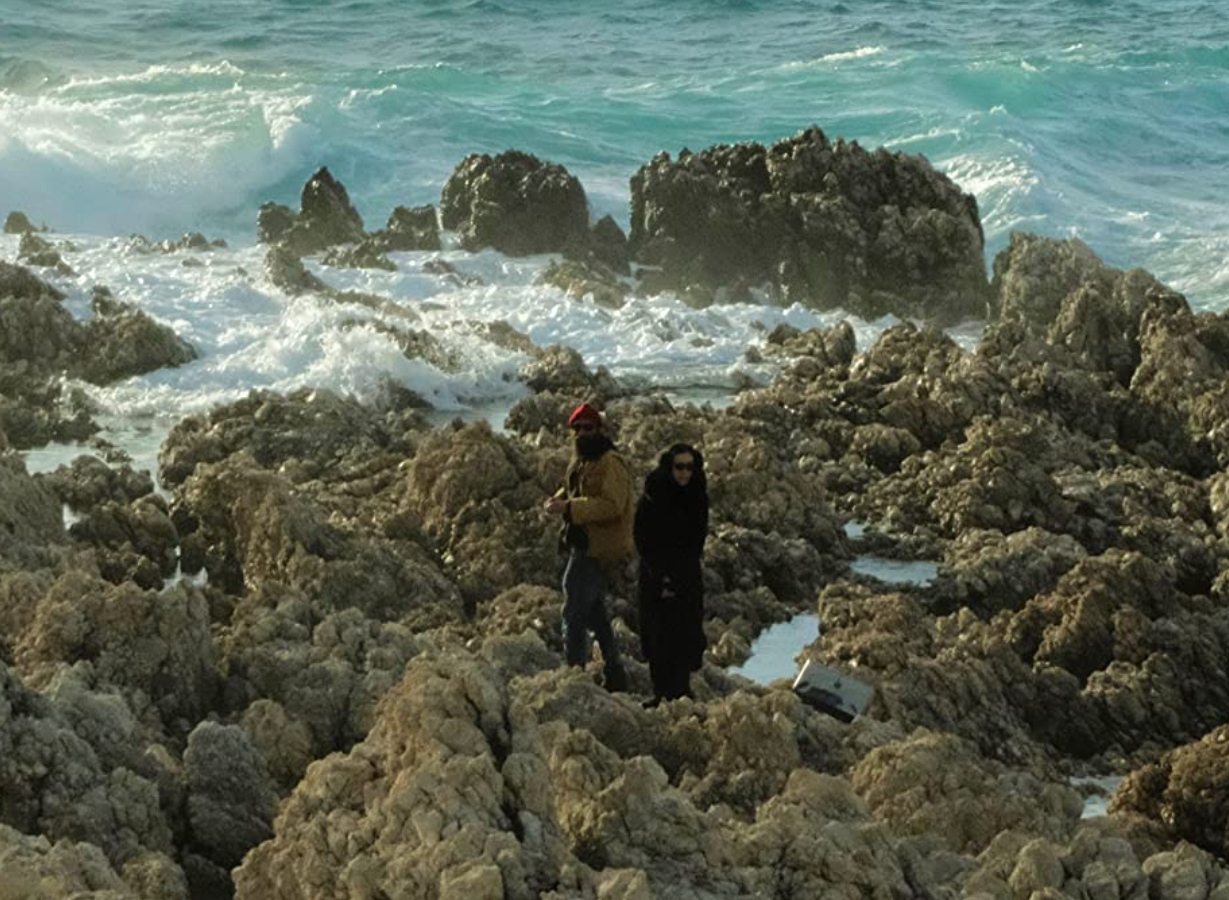 Still from Magnetic Fields
Still from Magnetic Fields
As you have said, you used a MiniDV camcorder for the filming due to budget restrictions, but you embraced the visual outcome and made it work for the benefit of the film. Apart for the aesthetic result, how much did this practically affect the filmmaking process? Doeas working with this type of camera generate a greater sense of intimacy with the characters?
Let me grab this chance to point out that when talking about budget restrictions, we don’t just mean the money needed to rent a state of the art movie camera, but also many other practical aspects of the filmmaking process. Like, for example, the MiniDV camera has a huge range of lenses that you can switch between using a simple zoom button, while in the movie camera we would have to rent, carry and constantly swap lenses just to see which shot works best for us. That alone saved us time, money and effort. Also, movie cameras require a larger crew who can operate them and carry them around. Another advantage of the MiniDV camcorder is its small size and weight, which allowed us to quickly and easily strap it on makeshift contraptions in the car. Yet, that doesn’t change the fact that it is a cheap home video camera and nothing guarantees it won’t malfunction or just stop recording. We lost quite a bit of footage, even a whole day’s worth of shooting, because nothing was recorded on the tape due to issues with the humidity. It’s all part of the game. You weigh your options and see what works for you and what matters more for your final decision. I’m not sure if the visual result makes the audience see the characters in a more intimate way, but what Antonis and Elena shared with me was that, thanks to the camcorder’s size, the filming distance and the small crew, they found it easier –in this particular movie, with these specific characters– to forget about the camera and feel more like they were living through something rather than performing.
The transition from comics to filmmaking is not something we see very often, although the job of the writer/illustrator of a graphic novel is in many ways similar to that of a writer/director in cinema. Did you experience this change of medium as a natural progression or a radical reinvention of your creative identity?
I am leaning more towards the latter. I would say more the latter than the former. I think the transition from one art to the other had mostly to do with some internal changes in me; I shifted from being an introvert to pursuing extroversion, from being immobile to looking for movement. Film and comics are both narrative arts, that is, their purpose is to tell a story. But the tools and techniques available to the creator are quite different for each art. The cartoonist is solitary, crouched over his drawing station; it all goes through his hands and he has total control over everything. The director, on the other hand, is always surrounded by people; interaction is his primary instrument, he moves locations, he travels, he gets cold or hot, and is in a constant search for control over things and for solutions to the never-ending problems that come up. For now, I’m fascinated and thoroughly enjoying the thrill and adrenaline rush you get from filmmaking, but I don’t think I’m done with comics either.
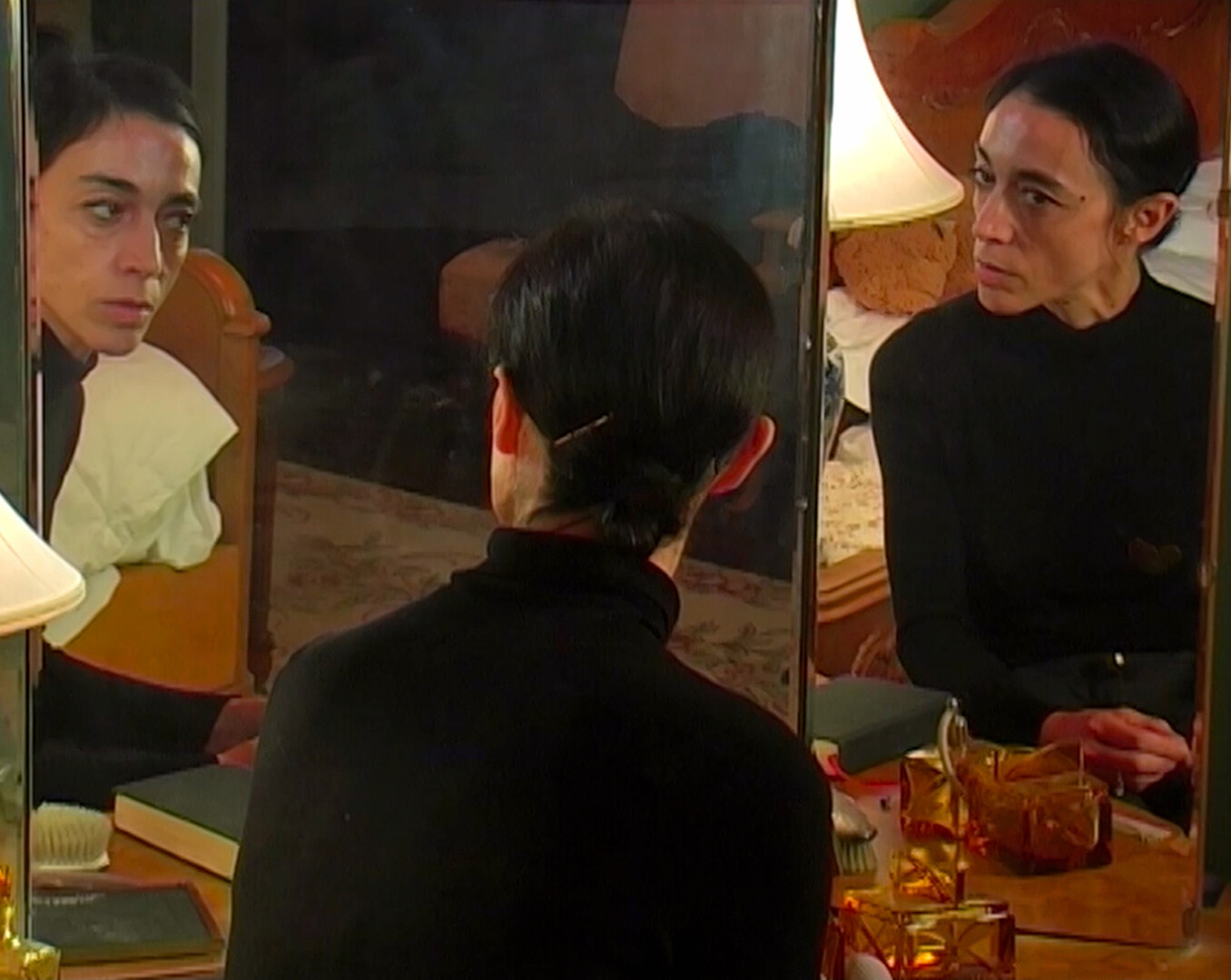 Still from Magnetic Fields
Still from Magnetic Fields
Were you involved in the artwork for the film’s poster, which has a cartoon-like aesthetic?
No, the poster was designed by graphic designer Anestis Neiros, and he was the one to choose its style. I don’t know if my also being a cartoonist influenced his decision, but I think that Magnetic Fields has an impressionist vibe to it, and the characters are always in the same clothes, like a costume, as is often the case with cartoon characters, so it wouldn’t be that strange to go to that direction even if I had not connection with comics myself.
When interview by Greek News Agenda on the graphic novel Erotokritos –which you illustrated–, writer Demosthenes Papamarkos said he resented the perceived lowbrow status of the fantasy, sci-fi, and horror genres in the Greek publishing world. How do you feel about the status of graphic novels in the industry?
Let me point out that the graphic novel is not a genre, like sci-fi or horror, but a format. Simply put, it is a comic book where the story is completed in one volume instead of being published in serial form, as was once the norm. At the moment, graphic novels have a momentum in the Greek publishing world, they have been welcomed by the readers and publishers and, those that have a good quality, are starting to find the place they deserve in bookstores, equal to that of traditional fiction. Since it has cartoon illustrations, this format is really suited for the sci-fi or horror genres, but I don’t think it is looked down upon by the publishers. A publisher wants to sell, so if a product could sell, they would not hesitate to print it. But because Greece is a small market due to the language barrier, we lack the critical mass of people that would make a book sell big simply because it is the kind of book they love. If a book is to become very successful commercially here, it has to be so good that it can cross the genre border and be read by everyone. And writing something that good has its own level of difficulty and scarcity. I personally think that if a very good writer, such as Papamarkos, whom you mentioned, were to write an excellent genre book, it would receive the acclaim it deserves.
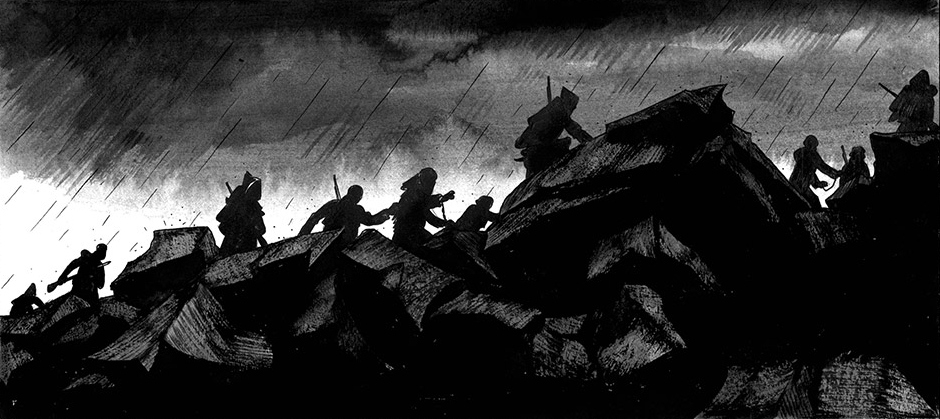 Image from the graphic novel Bandits
Image from the graphic novel Bandits
What do you have in store for the future – both as a cartoonist and a filmmaker?
I’m currently in post production on my next feature film, the documentary The arm wrestler, an expansion of my 2019 short film of the same name. I think the production will be completed within the first months of 2022.
As for comics, I am committed to illustrate the second and final volume of the graphic novel Bandits, to complete the story that was released last year by Polaris Publications. It is a comic book inspired by the lives of two bandits from Epirus, who were active in 1917-1930 in that broader region and the Balkans.
*Interview – Translation: Nefeli Mosaidi (Intro image: Still from Magnetic Fields)
Read also via Greek News Agenda: Reading Greece | Dimosthenis Papamarkos: “I would like to see more works of the fantasy, sci-fi, and horror genre in Greek literature”; Filming Greece | Jacqueline Lentzou on the Utopia of Belonging; Filming Greece | Digger: Georgis Grigorakis and the fragility of the lone rider

